formerly eScholarship Editions


|
|
|
|
Your request for similar items found 20 book(s). | Modify Search | Displaying 1 - 20 of 20 book(s) | |
| 1. | 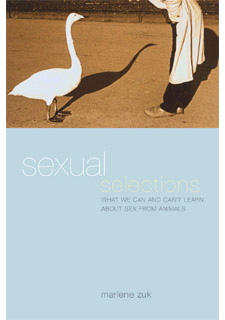 | Title: Sexual selections: what we can and can't learn about sex from animals Author: Zuk, M. (Marlene) Published: University of California Press, 2002 Subjects: Organismal Biology | Cultural Anthropology | Evolution | Gender Studies | Animal Behavior | Sociology | Biology Publisher's Description: Scientific discoveries about the animal kingdom fuel ideological battles on many fronts, especially battles about sex and gender. We now know that male marmosets help take care of their offspring. Is this heartening news for today's stay-at-home dads? Recent studies show that many female birds once thought to be monogamous actually have chicks that are fathered outside the primary breeding pair. Does this information spell doom for traditional marriages? And bonobo apes take part in female-female sexual encounters. Does this mean that human homosexuality is natural? This highly provocative book clearly shows that these are the wrong kinds of questions to ask about animal behavior. Marlene Zuk, a respected biologist and a feminist, gives an eye-opening tour of some of the latest developments in our knowledge of animal sexuality and evolutionary biology. Sexual Selections exposes the anthropomorphism and gender politics that have colored our understanding of the natural world and shows how feminism can help move us away from our ideological biases. As she tells many amazing stories about animal behavior--whether of birds and apes or of rats and cockroaches--Zuk takes us to the places where our ideas about nature, gender, and culture collide. Writing in an engaging, conversational style, she discusses such politically charged topics as motherhood, the genetic basis for adultery, the female orgasm, menstruation, and homosexuality. She shows how feminism can give us the tools to examine sensitive issues such as these and to enhance our understanding of the natural world if we avoid using research to champion a feminist agenda and avoid using animals as ideological weapons. Zuk passionately asks us to learn to see the animal world on its own terms, with its splendid array of diversity and variation. This knowledge will give us a better understanding of animals and can ultimately change our assumptions about what is natural, normal, and even possible. [brief] Similar Items |
| 2. | 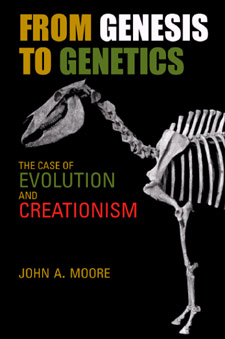 | Title: From Genesis to genetics: the case of evolution and creationism Author: Moore, John Alexander 1915- Published: University of California Press, 2002 Subjects: Science | Christianity | History of Science Publisher's Description: The clash between evolution and creationism is one of the most hotly contested topics in education today. This book, written by one of America's most distinguished science educators, provides essential background information on this difficult and important controversy. Giving a sweeping and balanced historical look at both schools of thought, John A. Moore shows that faith can exist alongside science, that both are essential to human happiness and fulfillment, but that we must support the teaching of science and the scientific method in our nation's schools. This highly informative book will be an invaluable aid for parents, teachers, and lawmakers, as well as for anyone who wants a better understanding of this debate. From Genesis to Genetics shows us why we must free both science and religion to do the good work for which each is uniquely qualified. Using accessible language, Moore describes in depth these two schools of thought. He begins with an analysis of the Genesis story, examines other ancient creation myths, and provides a nuanced discussion of the history of biblical interpretation. After looking at the tenets and historical context of creationism, he presents the history of evolutionary thought, explaining how it was developed, what it means, and why it is such a powerful theory. Moore goes on to discuss the relationship of nineteenth-century religion to Darwinism, examine the historic Scopes trial, and take us up to the current controversy over what to teach in schools. Most important, this book also explores options for avoiding confrontations over this issue in the future. Thoughtfully and powerfully advocating that the teaching of science be kept separate from the teaching of religion, Moore asks us to recognize that a vigorous and effective scientific community is essential to our nation's health, to our leadership role in the world, and to the preservation of a healthy environment. [brief] Similar Items |
| 3. | 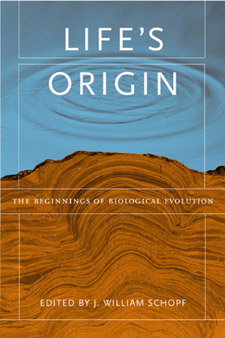 | Title: Life's origin: the beginnings of biological evolution Author: Schopf, J. William 1941- Published: University of California Press, 2002 Subjects: Organismal Biology | Paleontology | Astronomy | Evolution | Earth Sciences | Physical Sciences Publisher's Description: Always a controversial and compelling topic, the origin of life on Earth was considered taboo as an area of inquiry for science as recently as the 1950s. Since then, however, scientists working in this area have made remarkable progress, and an overall picture of how life emerged is coming more clearly into focus. We now know, for example, that the story of life's origin begins not on Earth, but in the interiors of distant stars. This book brings a summary of current research and ideas on life's origin to a wide audience. The contributors, all of whom received the Oparin/Urey Gold Medal of the International Society for the Study of the Origin of Life, are luminaries in the fields of chemistry, paleobiology, and astrobiology, and in these chapters they discuss their life's work: understanding the what, when, and how of the early evolution of life on Earth. Presented in nontechnical language and including a useful glossary of scientific terms, Life's Origin gives a state-of-the-art encapsulation of the fascinating work now being done by scientists as they begin to characterize life as a natural outcome of the evolution of cosmic matter. [brief] Similar Items |
| 4. | 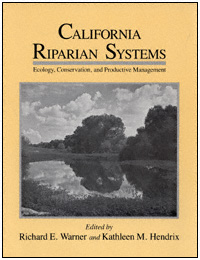 | Title: California riparian systems: ecology, conservation, and productive management Author: Warner, Richard E Published: University of California Press, 1984 Subjects: Environmental Studies | California and the West Publisher's Description: This volume presents 135 of the papers presented at the 1981 California Riparian Systems Conference. The papers address all aspects of riparian systems: habitat, wildlife, land management, land use policy planning, conservation and water resource management. Similar Items |
| 5. | 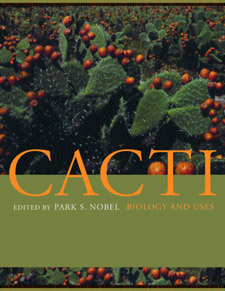 | Title: Cacti: biology and uses Author: Nobel, Park S Published: University of California Press, 2002 Subjects: Organismal Biology | EcologyEvolutionEnvironment | Botany | Plants | Agriculture Publisher's Description: The Cactaceae family, with about sixteen hundred species, is cultivated worldwide for fruits, forage, fodder, and even as a vegetable. Cacti are recognized for their attractive flowers, special stem shapes, and ability to tolerate drought. Because of their efficient use of water and other adaptations, biological and agronomic interest in cacti has soared. These fascinating plants also have much to teach us about biodiversity and conservation. Yet a current, synthetic, wide-ranging reference on cacti has not been available until now. This comprehensive book, compiled by a well-known cactus biologist, includes authoritative, up-to-date chapters by thirty-five contributors from around the world on topics ranging from evolution to biotechnology. It is the first book of its kind to compile information on cactus biology, ecology, and uses in one convenient place. The first half of the book provides a thorough overview of cactus biology and morphology and discusses the environmental and conservation issues that affect the plants. It includes a discussion of the evolution of the family, paying particular attention to new genetic and molecular approaches. The second half of the book focuses on the practical concerns of cultivating cacti, such as pest control and diseases, horticultural and forage applications, and techniques for agronomy. Other chapters cover the different markets for cacti and products that are made from them. This unique volume will be a reliable and informative reference for ecologists and environmentalists, agriculturists, plant biologists, and anyone seriously interested in these remarkable plants. [brief] Similar Items |
| 6. | 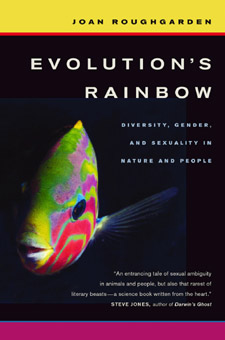 | Title: Evolution's rainbow: diversity, gender, and sexuality in nature and people Author: Roughgarden, Joan Published: University of California Press, 2004 Subjects: Gender Studies | EcologyEvolutionEnvironment | Anthropology | Evolution | Health Care | Social Problems | GayLesbian and Bisexual Studies | Social Problems Publisher's Description: In this innovative celebration of diversity and affirmation of individuality in animals and humans, Joan Roughgarden challenges accepted wisdom about gender identity and sexual orientation. A distinguished evolutionary biologist, Roughgarden takes on the medical establishment, the Bible, social science - and even Darwin himself. She leads the reader through a fascinating discussion of diversity in gender and sexuality among fish, reptiles, amphibians, birds, and mammals, including primates. Evolution's Rainbow explains how this diversity develops from the action of genes and hormones and how people come to differ from each other in all aspects of body and behavior. Roughgarden reconstructs primary science in light of feminist, gay, and transgender criticism and redefines our understanding of sex, gender, and sexuality. Witty, playful, and daring, this book will revolutionize our understanding of sexuality. Roughgarden argues that principal elements of Darwinian sexual selection theory are false and suggests a new theory that emphasizes social inclusion and control of access to resources and mating opportunity. She disputes a range of scientific and medical concepts, including Wilson's genetic determinism of behavior, evolutionary psychology, the existence of a gay gene, the role of parenting in determining gender identity, and Dawkins's "selfish gene" as the driver of natural selection. She dares social science to respect the agency and rationality of diverse people; shows that many cultures across the world and throughout history accommodate people we label today as lesbian, gay, and transgendered; and calls on the Christian religion to acknowledge the Bible's many passages endorsing diversity in gender and sexuality. Evolution's Rainbow concludes with bold recommendations for improving education in biology, psychology, and medicine; for democratizing genetic engineering and medical practice; and for building a public monument to affirm diversity as one of our nation's defining principles. [brief] Similar Items |
| 7. | 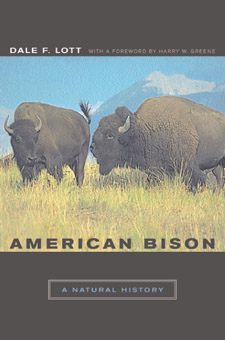 | Title: American bison: a natural history Author: Lott, Dale F Published: University of California Press, 2002 Subjects: Organismal Biology | Mammalogy | Animals | Animal Behavior | Science | Natural History Publisher's Description: American Bison combines the latest scientific information and one man's personal experience in an homage to one of the most magnificent animals to have roamed America's vast, vanished grasslands. Dale F. Lott, a distinguished behavioral ecologist who was born on the National Bison Range and has studied the buffalo for many years, relates what is known about this iconic animal's life in the wild and its troubled history with humans. Written with unusual grace and verve, American Bison takes us on a journey into the bison's past and shares a compelling vision for its future, offering along the way a valuable introduction to North American prairie ecology. We become Lott's companions in the field as he acquaints us with the social life and physiology of the bison, sharing stories about its impressive physical prowess and fascinating relationships. Describing the entire grassland community in which the bison live, he writes about the wolves, pronghorn, prairie dogs, grizzly bears, and other animals and plants, detailing the interdependent relationships among these inhabitants of a lost landscape. Lott also traces the long and dramatic relationship between the bison and Native Americans, and gives a surprising look at the history of the hide hunts that delivered the coup de grâce to the already dwindling bison population in a few short years. This book gives us a peek at the rich and unique ways of life that evolved in the heart of America. Lott also dismantles many of the myths we have created about these ways of life, and about the bison in particular, to reveal the animal itself: ruminating, reproducing, and rutting in its full glory. His portrait of the bison ultimately becomes a plea to conserve its wildness and an eloquent meditation on the importance of the wild in our lives. [brief] Similar Items |
| 8. | 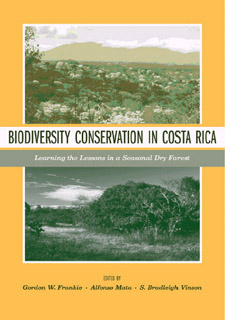 | Title: Biodiversity conservation in Costa Rica: learning the lessons in a seasonal dry forest Author: Frankie, G. W Published: University of California Press, 2004 Subjects: EcologyEvolutionEnvironment | Ecology | Conservation | Latin American Studies Publisher's Description: The beautiful tropical dry forest of northwest Costa Rica, with its highly seasonal rainfall and diversely vegetated landscape, is disappearing even more rapidly than Costa Rica's better-known rain forest, primarily because it has been easier to convert to agriculture. This book, based on more than thirty years of study, offers the first comprehensive look at the ecology, biodiversity, and conservation status of this endangered and fragile region. The contributors, from Costa Rica, Britain, Mexico, and the United States, and representing the fields of ecology, environmental education, policy, and the law, examine the major plant and animal groups living in the dry forest and present the first technical evaluation of Costa Rica's conservation efforts. As they assess the status of their area of specialty in the dry forest, the contributors also look beyond this particular region to show how its plants and animals are ecologically and evolutionarily connected to other geographic areas in Costa Rica and Central America. Their chapters cover topics such as watershed and coastal management, plant phenology, pollination, insects, birds, mammals, amphibians, and reptiles. They also consider the socioeconomic, policy, legal, and political aspects of biodiversity conservation, giving the volume a wide-ranging perspective and making a unique contribution to our knowledge of the tropical dry forest. The book concludes with an important synthesis of the contributors' recommendations on future directions, policies, and actions that will better conserve biodiversity in Costa Rica and other neotropical forests as well. [brief] Similar Items |
| 9. |  | Title: Evolution of sickness and healing Author: Fabrega, Horacio Published: University of California Press, 1997 Subjects: Medicine | Medical Anthropology Publisher's Description: Evolution of Sickness and Healing is a theoretical work on the grand scale, an original synthesis of many disciplines in social studies of medicine. Looking at human sickness and healing through the lens of evolutionary theory, Horacio Fàbrega, Jr. presents not only the vulnerability to disease and injury but also the need to show and communicate sickness and to seek and provide healing as innate biological traits grounded in evolution. This linking of sickness and healing, as inseparable facets of a unique human adaptation developed during the evolution of the hominid line, offers a new vantage point from which to examine the institution of medicine.To show how this complex, integrated adaptation for sickness and healing lies at the root of medicine, and how it is expressed culturally in relation to the changing historical contingencies of human societies, Fàbrega traces the characteristics of sickness and healing through the early and later stages of social evolution. Besides offering a new conceptual structure and a methodology for analyzing medicine in evolutionary terms, he shows the relevance of this approach and its implications for the social sciences and for medical policy. Health scientists and medical practitioners, along with medical historians, economists, anthropologists, and sociologists, now have the opportunity to consider every essential aspect of medicine within an integrated framework. [brief] Similar Items |
| 10. | 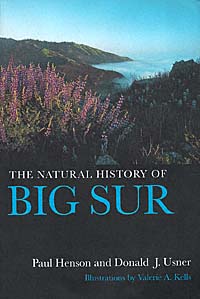 | Title: The natural history of Big Sur Author: Henson, Paul 1959- Published: University of California Press, 1993 Subjects: Environmental Studies | California and the West | Natural History | Ecology Publisher's Description: Each year millions of people visit the area of rugged California coastline and wild mountains known as Big Sur. Finally here is a book that is both a natural history of this beautiful region and an excellent guide to its extensive public lands. The first section introduces the area's geology, climate, flora, fauna, and human history. The second section describes selected sites, trails, and features that are mentioned in Part One.Although Big Sur is world famous for awe-inspiring scenery, it is less known for its great ecological diversity and its significance as a haven for many species of terrestrial and marine wildlife. In no other part of the world do fog-loving coastal redwoods thrive on one slope of a canyon while arid-climate yuccas grow on the other. Similarly, sea otters and cormorants live near dry-climate creatures like canyon wrens and whiptail lizards. The area's staggering beauty and forbidding wilderness have inspired artists, poets, naturalists, and hikers - and also real estate developers.As increasing tourism, development pressure, and land-use decisions continue to affect Big Sur, this book will do much to heighten awareness of the region's biotic richness and fragility. Written in nontechnical language, with generous color photographs, drawings, maps, species lists, and a bibliography, it will attract both the casual and the serious naturalist, as well as anyone concerned about preserving California's natural heritage. [brief] Similar Items |
| 11. | 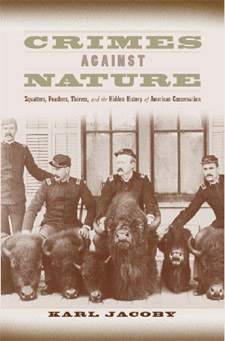 | Title: Crimes against nature: squatters, poachers, thieves, and the hidden history of American conservation Author: Jacoby, Karl 1965- Published: University of California Press, 2001 Subjects: History | United States History | Natural History Publisher's Description: Crimes against Nature reveals the hidden history behind three of the nation's first parklands: the Adirondacks, Yellowstone, and the Grand Canyon. Focusing on the impact that conservation in these areas had on rural people, Karl Jacoby traces the effect of criminalizing such traditional practices as hunting and fishing, foraging, and timber cutting in these newly created parks. Jacoby reassesses the nature of these "crimes" and provides a rich portrait of rural people and their relationship with the natural world in the late nineteenth and early twentieth centuries. This engagingly written study demonstrates the important ways in which class has influenced environmental history. [brief] Similar Items |
| 12. | 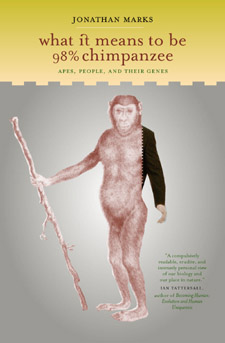 | Title: What it means to be 98% chimpanzee: apes, people, and their genes Author: Marks, Jonathan (Jonathan M.) 1955- Published: University of California Press, 2002 Subjects: EcologyEvolutionEnvironment | Evolution | Physical Anthropology | Sociology | Medicine | Mammalogy Publisher's Description: The overwhelming similarity of human and ape genes is one of the best-known facts of modern genetic sciencenm. But what does this similarity mean? Does it, as many have suggested, have profound implications for understanding human nature? Well-known molecular anthropologist Jonathan Marks uses the human-versus-ape controversy as a jumping-off point for a radical reassessment of a range of provocative issues--from the role of science in society to racism, animal rights, and cloning. Full of interesting facts, fascinating personalities, and vivid examples that capture times and places, this work explains and demystifies human genetic science--showing ultimately how it has always been subject to social and political influences and teaching us how to think critically about its modern findings. Marks presents the field of molecular anthropology--a synthesis of the holistic approach of anthropology with the reductive approach of molecular genetics--as a way of improving our understanding of the science of human evolution. As he explores the intellectual terrain of this field, he lays out its broad areas of interest with issues ranging from the differences between apes and humans to the biological and behavioral variations expressed in humans as a species. Marks confronts head-on the problems of racial classification in science. He describes current theories about race and uses work in primatology, comparative anatomy, and molecular anthropology to debunk them. He also sheds new light on the controversial Great Ape Project, the Human Genome Diversity Project, and much more. This iconoclastic, witty, and extremely readable book illuminates the deep background of human variation and asks us to reconsider the role of science in modern society. [brief] Similar Items |
| 13. | 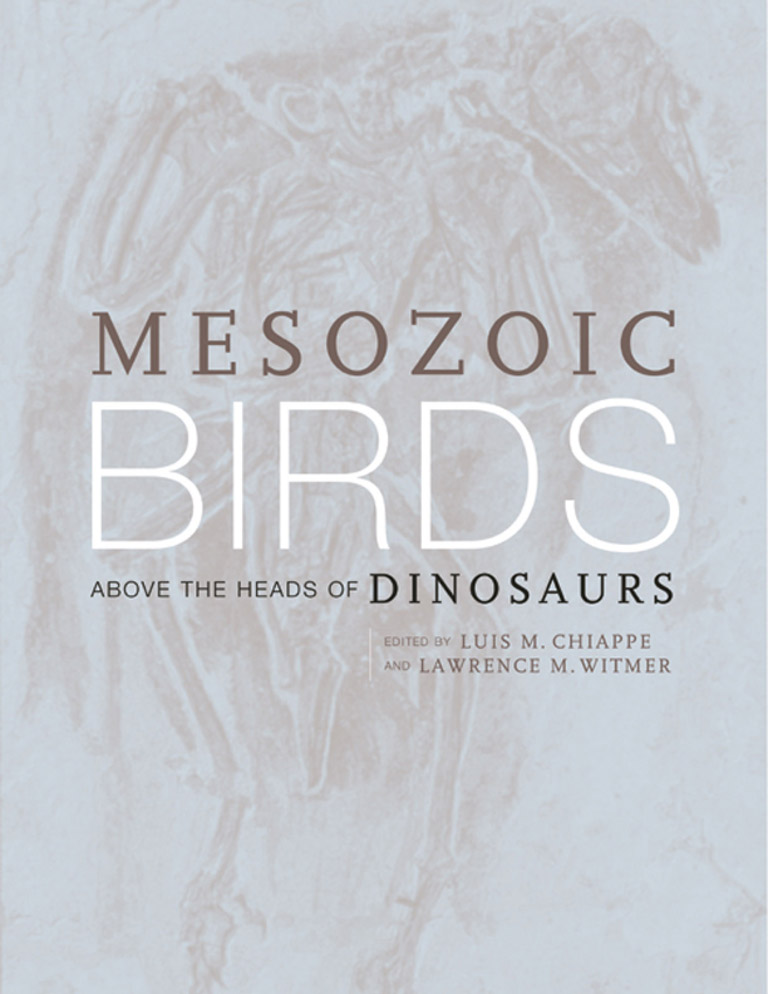 | Title: Mesozoic birds: above the heads of dinosaurs Author: Chiappe, Luis M Published: University of California Press, 2002 Subjects: Organismal Biology | Ornithology | Paleontology | Evolution Publisher's Description: Our knowledge of the origin and early evolution of birds has exploded in the past ten to fifteen years. In the 1990s alone, scientists became aware of approximately three times more species of early birds than were previously known, marking the first 85 million years of avian development as a period of remarkable species diversity. Assembling work by an international group of renowned scientists, Mesozoic Birds: Above the Heads of Dinosaurs is the most authoritative and up-to-date source on early avian evolution currently available. This unique resource provides a comprehensive examination of the known fossil record and is also an unparalleled guide to the fast-paced developments in current research. Mesozoic Birds: Above the Heads of Dinosaurs covers a wide range of topics, including discussions of avian origins, the fossil record of feathers and footprints, bone histology, and locomotor evolution. Controversial taxa such as Protoavis, Caudipteryx, and Mononykus receive special treatment. But the heart of the volume presents the anatomy, relationships, and paleobiology of the undisputed Mesozoic aviary. Some of the book's most exciting features are the new definitive descriptions and illustrations of taxa that previously have received only brief notice, such as the alvarezsaurid Shuvuuia; the enantiornithines Sinornis; Eoalulavis, Vorona, and Patagopteryx; and the hesperornithiform Enaliornis. The origin of birds and their relationship to dinosaurs continue to be hotly debated among paleontologists, ornithologists, and evolutionary biologists. This cutting-edge reference will become an essential resource for those interested in this debate and in the many other fascinating topics relating to the evolution of the earliest known birds. [brief] Similar Items |
| 14. |  | Title: Natural history of the White-Inyo Range, eastern California Author: Hall, Clarence A Published: University of California Press, 1991 Subjects: Environmental Studies | Ecology | Earth Sciences | California and the West | Natural History Publisher's Description: The White-Inyo Range - rising sharply from the eastern edge of Owens Valley - is one of the most extraordinary landscapes in the world. High, dry, and amazingly diverse, it boasts an expansive alpine tundra and features the oldest living species on earth - the 4,000-year-old Bristlecone Pines. This colorful and authoritative volume assembles a wealth of information of deep interest to the hikers and scientists attracted to White-Inyo's altitude and isolation.The nearly two dozen contributors to the volume are leading experts on the flora and fauna, the geology, geomorphology, meteorology, anthropology, and archaeology of the area. The book offers descriptions of more than 650 kinds of living organisms, from the handful of fish to the abundance of reptile, amphibian, bird and plant species. (It provides descriptions of hundreds of flowering plants.) It contains an 8-color geologic map and a roadside guide that enables the visitor to make sense of the area's complex geological history. Readers will also learn about air currents that make the range a delight for sailplane pilots and create strange cloud formations. And a special chapter tells what is known of the Native Americans who moved up and down the mountain slopes in response to seasonal changes.For anyone who wishes to visit this astonishing area or to do research there, this volume will be a unique, comprehensive resource. [brief] Similar Items |
| 15. | 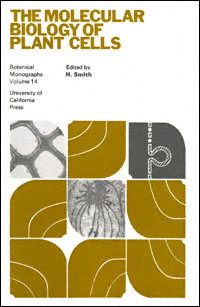 | Title: The molecular biology of plant cells Author: Smith, H. (Harry) 1935- Published: University of California Press, 1978 Subjects: Science | Botany | Biology Similar Items |
| 16. | 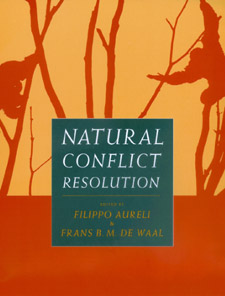 | Title: Natural conflict resolution Author: Aureli, Filippo 1962- Published: University of California Press, 2000 Subjects: Science | Zoology | Psychology | Cultural Anthropology | Politics | Sociology Publisher's Description: Aggression and competition are customarily presented as the natural state of affairs in both human society and the animal kingdom. Yet, as this book shows, our species relies heavily on cooperation for survival as do many others - from wolves and dolphins to monkeys and apes. A distinguished group of fifty-two authors, including many of the world's leading experts on human and animal behavior, review evidence from multiple disciplines on natural conflict resolution, making the case that reconciliation and compromise are as much a part of our heritage as is waging war. Chimpanzees kiss and embrace after a fight. Children will appeal to fairness when fighting over a toy. Spotted hyenas, usually thought to be a particularly aggressive species, use reconciliation to restore damaged relationships. As these studies show, there are sound evolutionary reasons for these peacekeeping tendencies. This book also addresses the cultural, ecological, cognitive, emotional, and moral perspectives of conflict resolution. [brief] Similar Items |
| 17. |  | Title: Fish: an enthusiast's guide Author: Moyle, Peter B Published: University of California Press, 1995 Subjects: Environmental Studies | Marine and Freshwater Sciences | Ecology | Sports | Biology Publisher's Description: Engagingly written, with both learning and humor, Fish bridges the gap between purely pictorial books and scholarly texts, and provides a succinct summary of fish biology and conservation for students and fish enthusiasts. Similar Items |
| 18. | 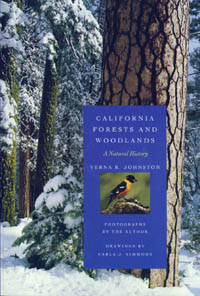 | Title: California forests and woodlands: a natural history Author: Johnston, Verna R Published: University of California Press, 1994 Subjects: Environmental Studies | Science | Ecology | Biology | California and the West Publisher's Description: From majestic Redwoods to ancient Western Bristlecone Pines, California's trees have long inspired artists, poets, naturalists - and real estate developers. Verna Johnston's splendid book, illustrated with her superb color photographs and Carla Simmons's detailed black-and-white drawings, now offers an unparalleled view of the Golden State's world-renowned forests and woodlands.In clear, vivid prose, Johnston introduces each of the state's dominant forest types. She describes the unique characteristics of the trees and the interrelationships of the plants and animals living among them, and she analyzes how fire, flood, fungi, weather, soil, and humans have affected the forest ecology. The world of forest and woodland animals comes alive in these pages - the mating games, predation patterns, communal life, and the microscopic environment of invertebrates and fungi are all here.Johnston also presents a sobering view of the environmental hazards that threaten the state's trees: acid snow, ozone, blister rust, over-logging. Noting the interconnectedness of the diverse life forms within tree regions, she suggests possible answers to the problems currently plaguing these areas. Enriched by the observations of early naturalists and Johnston's many years of fieldwork, this is a book that will be welcomed by all who care about California's treasured forests and woodlands. [brief] Similar Items |
| 19. | 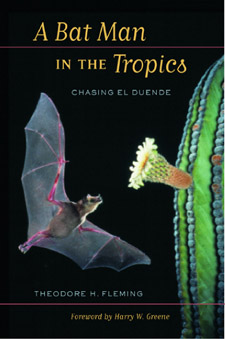 | Title: A bat man in the tropics: chasing El Duende Author: Fleming, Theodore H Published: University of California Press, 2003 Subjects: Organismal Biology | Mammalogy | Autobiography | Ecology Publisher's Description: The euphoria of discovery is the only motivation many scientists need for studying nature and its secrets. Yet euphoria is rarely expressed in scientific publications. This book, a personal account of more than thirty years of fieldwork by one of the world's leading bat biologists, wonderfully conveys the thrill of scientific discovery. Theodore Fleming's work to document the lives and ecological importance of plant-visiting bats has taken him to the tropical forests of Panama, Costa Rica, and Australia, and to the lush Sonoran Desert of northwest Mexico and Arizona. This book tells the story of his fascinating career and recounts his many adventures in the field. Fleming weaves autobiographical reflections together with information on the natural history and ecology of bats and describes many other animals and plants he has encountered. His book details the stresses and rewards of life in scientific field camps, gives portraits of prominent biologists such as Dan Janzen and Peter Raven, and traces the development of modern tropical biology. A witness to the destruction and development of many of the forests he has visited throughout his career, Fleming makes a passionate plea for the conservation of these wild places. [brief] Similar Items |
| 20. | 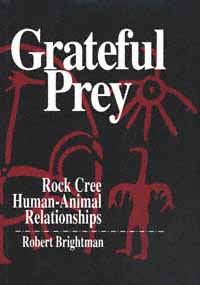 | Title: Grateful prey: Rock Cree human-animal relationships Author: Brightman, Robert Alain 1950- Published: University of California Press, 1993 Subjects: Anthropology | Anthropology | United States History | Religion Publisher's Description: The interaction between religious beliefs and hunting practices among the Asiniskawidiniwak or Rock Crees of northern Manitoba is the focus of Robert Brightman's detailed study. This foraging society, he says, bases aspects of its hunting and trapping largely on what we call "religious" conceptions.Seeking an ideology, however, that incorporates Cree beliefs about human-animal differences and the relationships that should exist between them as hunter and prey, Brightman finds these beliefs to be disordered and unstable rather than systematic. Animals are represented as simultaneously more and less powerful than humans. The hunter-prey relationship is talked about as both collaborative and adversarial. Exploring the influence of these religious representations on technical aspects of subsistence historically, Brightman finds that Crees' attitudes and actions toward animals were, and are, relatively arbitrary with respect to biological and environmental forces. Anthropologists will see in his well-researched discussion a challenge to prevailing ecological and Marxist approaches to foraging societies. [brief] Similar Items |